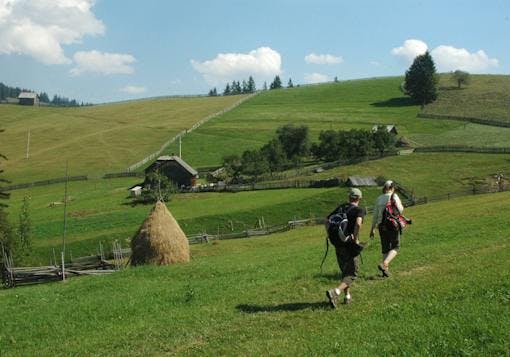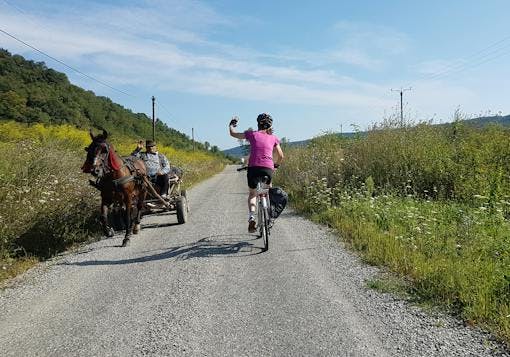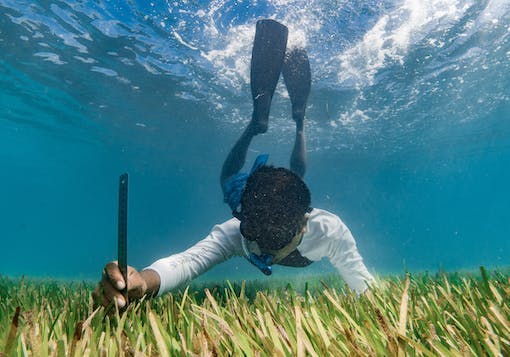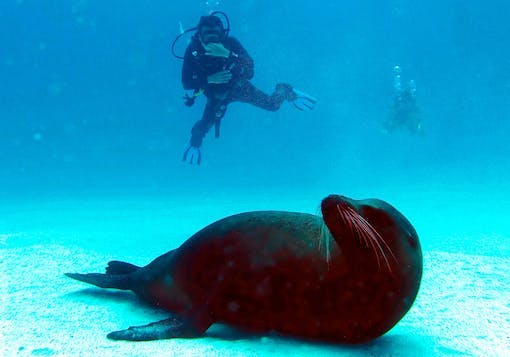Carbon Offsets & Carbon Removals Explained
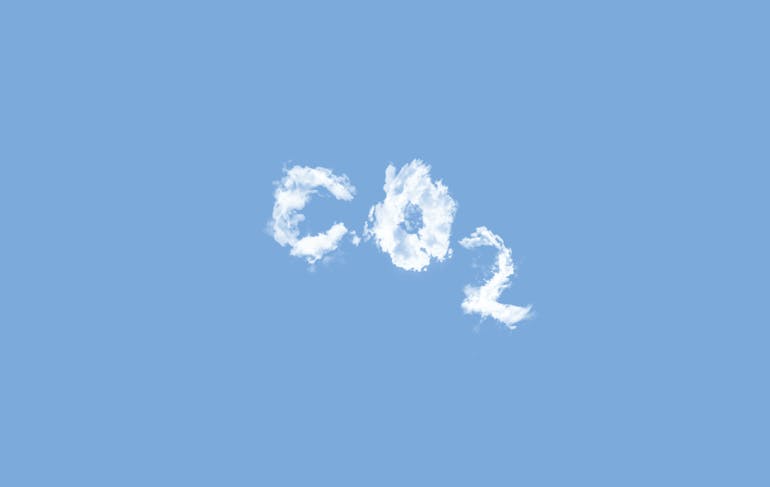
04
Oct
Carbon Offsets & Carbon Removals Explained
Carbon offsets and carbon removals are two types of purchases travelers can make to mitigate their impact on the environment.
Air travel is bad for the environment. The travel and tourism industry is estimated to contribute 12% of global CO2 emissions by 2025, about half of which is driven by transportation including flights, according to Sustainable Travel International. At a high level, we need government regulation and more corporate action from big companies (especially airlines) to enact meaningful, long-term change with global impact. On an individual level, being familiar with one’s travel emissions, carbon calculators, carbon offset programs, and carbon removal technologies is a great starting point to becoming a better-informed and more action-oriented responsible traveler.
Let’s start by taking a closer look at carbon offsets, which you have probably heard of before. We’ll dive into carbon removals, a new topic for many, right after that.
What are carbon offsets?
Carbon offsets refer to programs or schemes designed to reduce or avoid future emissions. Sometimes, carbon offsets also refer to the removal of carbon, but we separate out these terms (“carbon offsets” and “carbon removals”) as there are important distinctions we’ll discuss below.
How do carbon offsets work?
Carbon offsets can be purchased by people or companies in an effort to negate or compensate for emissions of carbon dioxide or other greenhouse gases. When purchased, what you’re usually buying is actually a carbon credit. Carbon credits “are measurable, verifiable emission reductions from certified climate action projects,” as described by South Pole, a climate and carbon consultancy that designs, develops, and implements carbon offset programs.
Examples of low-carbon impact trips in Portugal are below.
What are examples of carbon offset projects?
There are many projects designed to help offset carbon, and generally, these offsetting schemes fall into four categories.
- Forestry: This includes all of the projects involving reforestation, or planting and maintaining trees. Reforestation projects are extremely common to see in this space, and what you may think of when you hear “carbon offsetting”.
- Energy: Energy projects for carbon mitigation are centered around renewable and solar-powered energy initiatives. This includes projects such as building wind farms or installing solar panels. Energy projects are also quite common to see.
- Community: Community projects focus on providing locals with appliances and equipment, like clean cookstoves, that allow them to conduct their daily lives in a way that emits less carbon. For example, clean cookstoves are more efficient at cooking food and use less fuel (sometimes they’re even solar-powered).
- Coasts: Coastal conservation projects involve preserving and caring for coastlines where there are wetlands like salt marshes or seagrasses, which are very effective carbon capture ecosystems. Coastal carbon projects get less visibility than some of the other project types – but check out the Blue Carbon Initiative for more information.
How can you purchase carbon offsets?
There are myriad companies selling carbon offsets. Some are designed to ‘offset your life’ while others are more specific, such as to help you offset emissions from your travels. Here are a few things to look for when choosing a carbon-offsetting company:
- What project types do they support? If you’re passionate about trees or the ocean, for example, you can find companies that specialize in these areas of impact.
- Are they certified? The Gold Standard and Verra are two of the most well-known certification labels for carbon offsetting schemes.
- Does the carbon offset organization practice transparency? This means not only describing the projects but also providing up-to-date proof via progress reports or annual reports on the initiatives and their effectiveness. Some companies will also link scientific documents or white papers backing up their work. The more information they provide about their work, the better you can evaluate the project’s legitimacy.
One way to travel more sustainably without separately buying carbon offsets on your own is to book tours through companies who are already doing this legwork for you. For example, Yugen Earthside's local partner in Türkiye leveraged the lull during Covid to work with South Pole to measure and act upon the carbon impact of each of their tours. They adjusted their itineraries to be more slow-travel-focused and incorporated the cost of offsetting the related carbon emissions into each of their trips, resulting in carbon-neutral experiences.
Discover some of our sustainable and carbon-neutral tours in Türkiye below.
Carbon offsets and the risk of greenwashing
When it comes to climate action and knowing which carbon offset programs are veritable, the waters can get murky quickly. There's no way around it: Preventing greenwashing is a challenge.
What is 'greenwashing'? Greenwashing is when companies make or use environmental claims, statements, or tactics to promote their products and brand, without being fully transparent about their sources or accuracy.
Some things to be mindful of:
- There are concerns about companies self-reporting projects and progress without much official oversight.
- There have been studies done showing that companies vastly over-report progress.
- There are tricky nuances to consider. For example, it’s not usually ‘trees’ being planted (even though that’s what companies will say), but rather ‘seedlings’. Seedlings have a much higher chance of dying before they can become effective carbon-capturing trees. An important consideration to be aware of is whether or not companies discuss reforestation in terms of protecting the long-term growth of what they plant, as opposed to just how much they’re planting.
Looking for certifications and transparency, combined with the types and quality of projects the company supports with these nuances in mind, should help you feel more confident about avoiding greenwashing. This leads us to…
Is carbon offsetting a scam? Do carbon offsets actually work?
Candidly, there are a lot of mixed reviews about whether or not carbon offsets do in fact work. While blanket statements declaring all carbon offset programs to be a scam may lack accuracy, it seems like more and more companies tout carbon offsetting efforts almost as a ‘get out jail free’ card.
There are reputable programs genuinely fighting the battle against climate change, but it can be hard to sift through what these are.
We cannot emphasize enough the need to seek out certified, transparent, and science-backed projects. We also urge mindful travelers to stay skeptical and ask questions before contributing to a program if they’re feeling unsure.
Examples of low-carbon impact trips in Romania are below.
Why can the price of carbon offsetting vary so much?
Something that may seem puzzling to people is why – or how – the price of carbon offsetting can vary so much. This contributes to the overwhelming nature of the topic: on top of finding verifiable projects, each person’s budget varies, and being overwhelmed with choices across a broad spectrum of price points further muddles things.
For example, we conducted a simple case study looking at two different offset methodologies for a round-trip flight between Seattle (SEA) and Paris (CDG).
- Sustainable Travel International: STI calculates the carbon footprint of an economy flight based on the mileage between SEA and CDG. Their results show 2.24 metric tonnes of CO2 which will cost $35.84 to offset ($16.00/metric tonne).
- Cool Effect: Cool Effect does not base its calculation on airport codes, but rather on ranges of flight times. The flight duration between Paris and Seattle is about 10 hours. Using the ’10-12 hours’ duration bucket, Cool Effect applies a long-haul estimate of 1.89 tonnes of CO2 per leg, so a round-trip flight would generate 3.78 tonnes, and cost $55.26 to offset ($14.62/metric tonne).
Here are six of the many reasons prices per metric tonne can vary:
- Project type: It costs different amounts to do something like plant a seedling compared to providing an energy-friendly cook stove.
- Project location: The country where a project is being implemented can affect the price. A project in Iceland will cost a different amount than a project in an African village.
- Implementation: Even once a project has been defined, it can cost variable amounts to roll out the implementation and oversight.
- Research and science: The cost of research and science used to develop and back projects can vary based on the number of scientists, their expertise, salaries, and time spent on the project.
- For-profit vs. not-for-profit: Whether or not the company behind a carbon initiative is a for-profit or a not-for-profit company can also affect how much they are charging for carbon offsets.
- Percent of the cost going to the project: Many projects will also tell you what percent of your payment for a carbon offset is actually going to the carbon project(s). Transparency here is key. For example, Cool Effect mentions research fees, credit card fees, registry fees, and admin fees, but there can also be fees related to marketing and education about carbon projects. Fees aren’t necessarily bad, but you should understand what they are as they will affect how much you pay for your offsets.
Should you buy carbon offsets?
In short, our stance is that, yes, buying credible carbon offsets is better than doing nothing.
This is not to take away from the myriad complications that come with offsets, as discussed above. It is also not to take away from the fact that major companies and countries should be drastically reducing emissions in the first place, and they are sorely failing us in this regard. (In fact, the magnitude of the problem seems almost comical to shift on to individuals; but somehow sitting by and doing absolutely nothing seems worse than at least encouraging education and action amongst travelers.)
Discover trips focused on scientific research and conservation.
What are carbon removals?
Carbon removals occur when existing carbon in the atmosphere is captured and permanently stored outside of the atmosphere. The effect of carbon removals is immediate, as compared to carbon offsets, which reduce or compensate for future emissions. What we like about carbon removals is that they feel less theoretical than carbon offsets: actual carbon is sequestered from our atmosphere in a quantifiable and measurable way; whereas with carbon offsets one might be left wondering if that seedling will actually become a carbon sink in the future. While carbon removals seem more tangible, some still call them a dangerous distraction from the pressing issue of slashing emissions.
Examples of carbon removal projects
Carbon removal projects involve taking carbon out of the atmosphere (sometimes called ‘negative CO2 emissions’) and storing it somewhere – generally underground. Carbon removals are not talked about as much in mainstream news, so you may be unfamiliar with these types of projects. We’ll walk you through two examples.
Tomorrow’s Air
Tomorrow’s Air uses technology to capture and store carbon:
- A carbon removal collector uses a fan to pull air into it.
- A filter inside the carbon removal collector captures carbon dioxide on its surface.
- When the filter is filled with carbon dioxide, the carbon collector is closed.
- Highly concentrated carbon dioxide from the filter is mixed with water and then pumped deep underground.
- Through natural mineralization, the CO2 reacts with basalt rock and turns into rock.
Tomorrow’s Air has wonderful resources to learn more about carbon removals, the science behind them, and more.

Nori
Nori is a marketplace for regenerative farmers who use soil for carbon capture and storage.
- A supplier reports a verifiable carbon removal project.
- An independent third party is brought to objectively estimate carbon removal.
- Separate third parties are brought in to verify the carbon removal project.
- A Nori Removal Tonne (NRT, one tonne of CO2 removed and stored for a minimum of 10 years), is created for additional carbon removal.
- Buyers purchase NRTs directly from the suppliers.
You can learn more about Nori’s process here.
Why are carbon removals so expensive?
Carbon removals tend to be far more expensive than carbon offsets. This is in large part because the technology being developed to sequester and store carbon is new. As with any technology, it is more expensive due to its novelty and the research, development, and innovation that goes into creating it. As the technology becomes more mainstream and demand for it increases, the price should come down in the future.
Should you buy carbon removals?
We are big fans of carbon removals! We strongly encourage all travelers to become Tomorrow’s Air subscribers. We love them because their innovative technology is transparent and practical, and they are focused on the travel sector. Further, they extensively work to educate and advocate for carbon removals and therefore push the cost of their technology down by increasing everyday demand through subscribership. (Disclaimer: We are not sponsored by Tomorrow’s Air. We are a corporate partner and we issue our carbon removals through Tomorrow's Air for each client who books a trip with us.)
Discover trips focused on local cultures and communities.
What’s better: carbon offsets or carbon removals?
Carbon offsets and carbon removals are inherently different, and accordingly, they both serve a purpose. Below, we compare key features of both carbon offsets and carbon removals.
The pros of carbon offsets:
- They are more affordable
- They can be purchased relatively easily through many verified NGO projects
- They are sometimes tax-deductible
The cons of carbon offsets:
- They impact the future – not today, and that’s only if they’re effectively managed in the long term
- The effect of carbon offsets is to reduce or avoid future emissions, not address any actual CO2 in the atmosphere today
- They can sometimes feel like a “get out of jail free” card for travelers and companies
- Prices are highly variable, making it difficult to decipher the differences between projects and the impact
The pros of carbon removals:
- They are extremely effective
- They have an impact today by removing existing carbon directly from the atmosphere
The cons of carbon removals:
- They are significantly more expensive, so many people can’t afford them
- The technology to capture carbon is new and it will take time for prices to come down
- There are fewer choices of companies doing verified carbon capture
To summarize: Carbon offsets are cheaper to buy but won’t impact carbon emissions already in the atmosphere; rather, they will help to reduce or avoid future emissions. Carbon removals are more expensive but they sequester carbon currently in the air via direct capture for permanent storage, and we believe this to be more effective than carbon offsets.
As a company, we remove carbon through a monthly Tomorrow’s Air subscription and offset the remaining carbon of our enterprise emissions through Pachama. We recommend our travelers follow a similar approach: Become a regular subscriber for carbon removals, and additionally offset what you cannot reduce or remove.
Note: Our monthly contributions to Tomorrow's Air on behalf of our company's corporate emissions is separate from the carbon removal contributions we make to Tomorrow's Air on behalf of each client who books a trip with us.
This leads us nicely to our company motto for Climate Impact…
How travelers can take climate action:
“REP” your Planet (Reduce, Estimate, Purchase)
R: Reduce your carbon emissions
Reduce your carbon emissions as much as possible in the first place. Here are nine ideas to reduce your carbon footprint from travel.
- Travel less frequently
- Stay in your destination longer
- Opt for trains or ferries instead of planes if possible: Alternative transportation methods like trains and ferries emit less than 16% of what a plane would emit.
- Take direct flights if flying is necessary. This BBC article sums it up well: “Taking off uses more fuel than cruising. For shorter flights, this accounts for a larger proportion of the journey.”
- Fly economy: this helps reduce the flight’s carbon emissions per passenger. A World Bank study, reported in Reuters, found that “flying business class emits about three times as much carbon as an economy class because the seats take up more room and more of them are empty.”
- Travel closer to home, or do “staycations”. Going shorter distances requires fewer emissions.
- Pack light. .The weight of a plane factors into how much fuel it uses and therefore how much emissions it emits.
- Prioritize public transportation. This goes for your transit to the airport or train station as well as once you’ve arrived at your destination. Bonus: this is generally the most budget-friendly way to get around, too!
- Choose trips centered around low-carbon impact activities. Think of walking, cycling, hiking, and trekking adventures.
Discover some of our cycling tours below.
E: Estimate your carbon emissions
For any unavoidable emissions resulting from your trip, take charge and estimate your vacation’s carbon footprint. There are simple tools like Air Miles Calculator and the International Civil Aviation Organization that will purely calculate the air mileage of your trip. There are also more complex tools like the Belgian company Green Tripper and the UK company Carbon Footprint that help estimate carbon emissions for additional trip components like other modes of transportation (cars, trains, and more), accommodation, and more.
Don’t worry if some of these tools give you different estimates, and also don’t fixate on achieving a “perfect” calculation. When it comes to being a responsible traveler, we advocate heavily for ‘progress over perfection.’ Being mindful of your carbon emissions and calculating your travel emissions are great steps that set you up for success with the third and final step, which is taking action.
We recommend picking a tool or two and testing them out, perhaps even comparing the results they give you. The most important thing is to find a tool that you like, trust, and can incorporate into your normal travel planning process.
What is ‘air mileage’? Air mileage, as opposed to standard (land) mileage, accounts for traveling through air mass. In other words, it accounts for wind. If you see this level of specificity in a carbon calculator tool, feel free to use it since technically it is more precise. However, don’t get hung up if you only see standard mileage on the calculator.
P: Purchase carbon removals and/or carbon offsets
Purchasing carbon removals and/or carbon offsets is how you can translate your awareness and preparedness from steps 1 and 2 into meaningful change. We recommend a blended approach of combining carbon removals and offsets to achieve net zero for your flight, overall trip, life, or company.
More resources on carbon offsets and carbon removals
Here are other ways you can think about having a positive impact on the environment when you travel:
- Choose tour companies (like us!) that take climate action, for example by automatically including carbon removals through Tomorrow's Air with each guest's booking, and optionally allowing clients to add-on carbon offsets to their trip through Sustainable Travel International.
- Choose airlines that are using newer fleets (which are more fuel-efficient), and making the transition to sustainable aviation fuel.
- Eat vegetarian (even if you don’t normally eat vegetarian, perhaps challenge yourself to do so for the duration of your trip!).
- Use sustainability filters on sites like Booking.com, or book your accommodation on sites that specifically focus on eco-friendly accommodation. See our roundup of the top 10 sites for sustainable hotels and accommodations here.
For more resources on carbon offsets and carbon removals, please visit our Climate Impact page.
This post was originally published on Aug. 31, 2022, and updated in October 2023.


